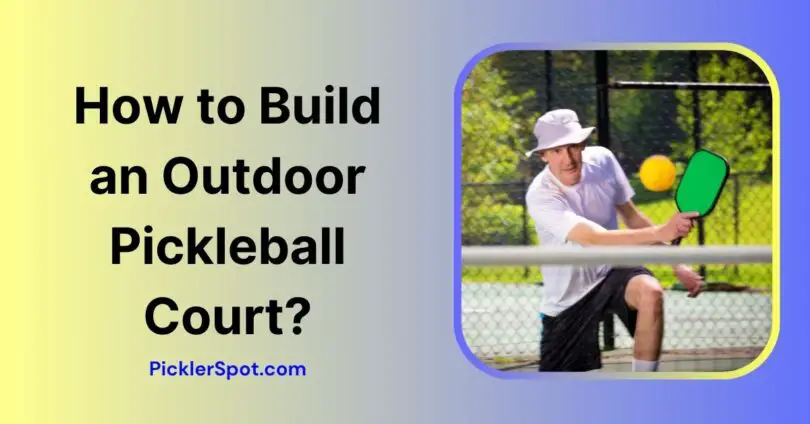If you are looking to give your backyard a complete overhaul and rejuvenate its beauty by simply making it productive, building an outdoor pickleball court might be the best way to start.
As long as you have the appropriate knowledge about its official dimensions specifications and other esoteric intricacies, you can even have your own dream court, whether it’s private or public.
It’s perfectly understandable that such feats are no walk in the park, but then again, you wouldn’t have to worry as long as you follow my sophisticated yet comprehensive guide on How to Build an Outdoor Pickleball Court.
Sounds interesting right? Scroll down to learn more about how to convert your patch of grass into a pickleball haven.
Building an Outdoor Pickleball Court – Steps
Make sure you follow every step mentioned below:
First Thing First, Getting The Right Dimensions
It’s pretty obvious that you clearly don’t want to spend all day in your backyard working on your court only to end up with poor or improper specifications, after all, everyone wants a real-life experience, close to the one you would see in private or public courts.
So the first and foremost thing you need to do is make sure that the dimension of the surface you are going to build your court on meets the United States Pickleball Association (USAPA) rules and regulations.
Make sure the area where you are going to build an outdoor pickleball court is 44 feet in length and measures around 20 feet in width. Keep in mind the court’s internal dimensions, to ensure an optimal experience, I would suggest that you at least keep a leeway of around 47 feet in length and 25 feet in width, in case you are planning to install benches, floodlighting, lamps, and other accessories to support your outdoor extracurricular activities.
Prepping the Surface
Next, you would be sacrificing your lawn for a good cause because in order to create a proper outdoor pickleball court, you need to ensure that it has a reinforced surface with either concrete or asphalt.
Since a pickleball is made from synthetic plastic, bouncing it on clay or mud isn’t optimal, in fact, it would ruin the trajectory of the ball that is being bounced on. Keep in mind that while the amount of digging might depend on the type of soil you may have to dig onto, the general rule of thumb is to dig around 4-6 inches in particular.
As a side note, I would also advise you to hire a worker, since digging with a shovel might be a tad bit too hard especially if you aren’t too good with shovels or don’t really have an idea of the depth of the soil that might be appropriate for filing.
Additionally, a construction worker or an engineer would also provide a rough idea of how the drainage system works around a pickleball court so that your court won’t get deluged once it rains.
Fill the Depth & Painting
Once you are done, it’s time for you to fill the place with thick concrete or asphalt material, make sure the whole area is evenly filled, you can even use a roller to balance out any unevenness. Moreover, use a measuring scale and a bubble level to check for the level of your court surface.
Let it take its time while it is being dried out under the sun, make sure the whole slab is dried out so that you won’t leave any imprints when stepping on the surface of the court.
Additionally, you need to ensure holes are left for the fixed post that will be holding the net in the middle of the court. Make sure the net hangs at 36 inches at the center while being raised 36 inches at the sides.
Once you are done with it, paint it with acrylic and use either blue or green for primary colors, and use either red, orange, or black for the secondary region to produce a visible spectrum regardless of the season you are playing.
You could either opt out for acrylic or epoxy paint to ensure it doesn’t wither away under scorching heat or in extreme winter. If you are living in extreme regions, using epoxy paint could do wonders for you.
Fencing Your Court
Not particularly pivotal in general if you are on a budget, fencing your court could be extremely helpful since you don’t want your pickleball to wander around whenever they are shot out of the boundary.
Use as creative as you can, in fact, you might want to use bamboo fencing if you want to introduce a charming zen look to your court. However, if you are looking towards a more traditional and safe route, using picket or chain fencing is also pretty feasible. Feel free to reinforce your pickleball court according to your budget.
Illuminating the Court
Next, install lamps all across the court, make sure you properly plan out the placement because too much or too little could ruin the experience. The best time to plan out your court illumination is obviously in the evenings when you have enough light to determine the position of your lamps.
The Accessories
Lastly, we have the fun part, clearly, you don’t want your pickleball buddies to feel withered whenever they are on the court. Installing vending machines, water bottle holders, equipment cupboards and lockers might be an amazing addition to spice up your court.
Moreover, you may also want to install a scoreboard to provide a professional experience and even add an enthusiastic vibe to it.
And that’s about it, your court is ready for hours of endless fun, feel free to invite your friends over so you can embark on private sessions all day long.
How to Build an Outdoor Pickleball Court? – Bottom Line
Building an outdoor pickleball court might be a bit of a hassle and after reading my guide on it, I am fairly certain it might feel like going out on a limb, however, trust me being a professional pickleball player myself it’s highly worth every effort and penny and invest into it.
If you are an individual who has just started getting into this sport, once you get the hang of it, the fun is truly endless.









